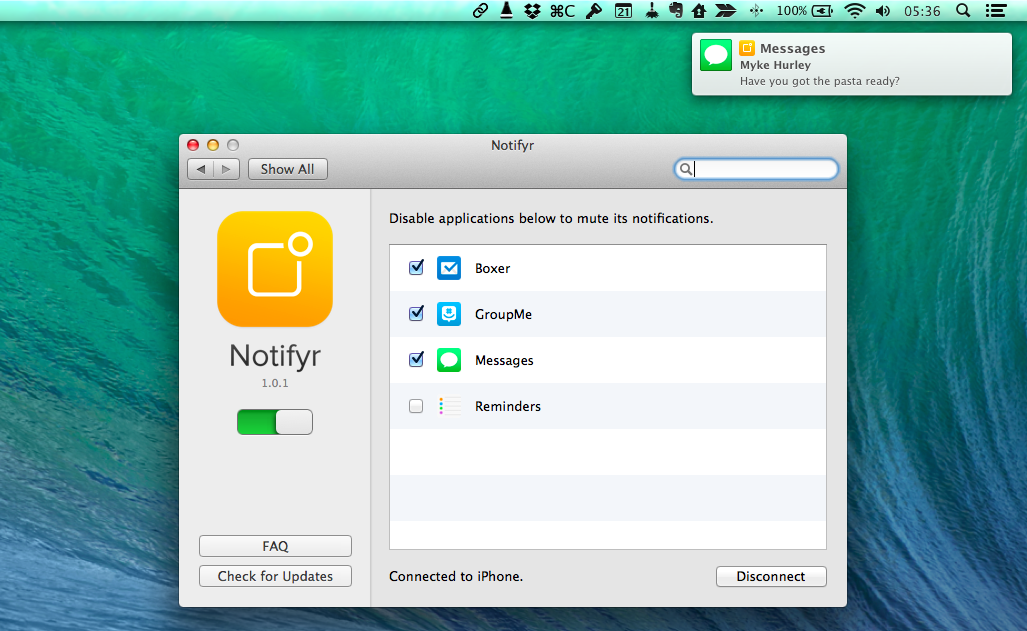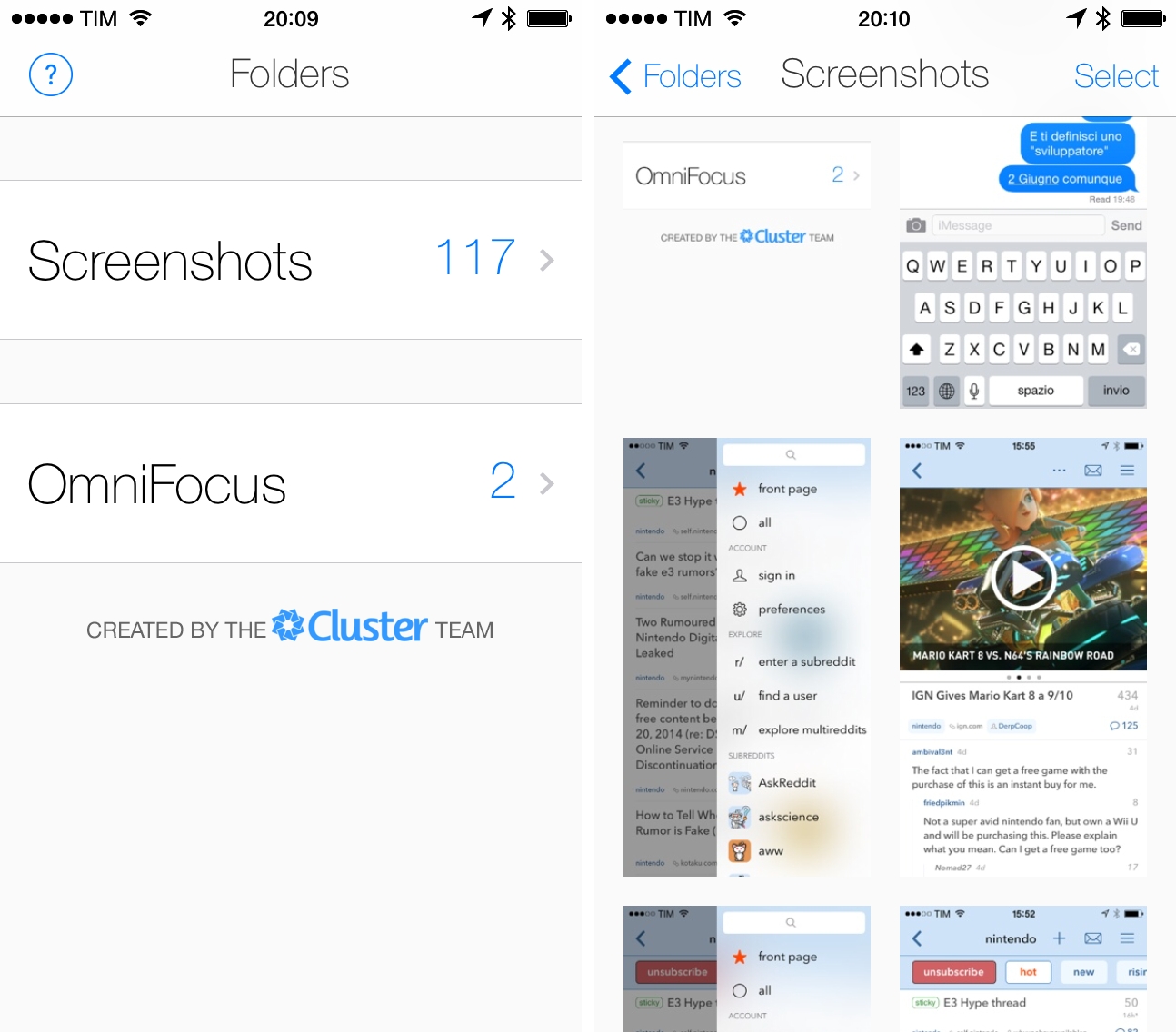Developed by Joost van Dijk, Notifyr is a handy utility that lets you receive iOS notifications on your Mac using Bluetooth Low Energy. I’ve been trying the app with my iPhone 5s and mid-2011 MacBook Air since yesterday, and it does indeed work as advertised, mirroring notification banners from any iOS app on my Mac.
Notifyr Lets You Receive iOS Notifications on Your Mac
Bounden, A Dancing Game for Two Players→
Developed by Game Oven in collaboration with the Dutch National Ballet, Bounden is a new iPhone dancing game for two players. The game uses the iPhone’s gyroscope and lets you “twist and twirl elegantly, or get entangled with a friend” in an experience that seems reminiscent of Game Oven’s previous work with Fingle and Bam fu for iOS, both games aimed at blurring the line between multitouch and physical interactions in iOS games.
Bounden looks like a unique concept, best explained by the promo video above and the developers’ description:
Holding either end of a device, you tilt the device around a virtual sphere following a path of rings. You swing your arms and twist your body, and before you know it, you are already dancing.
Bounden is $3.99 on the App Store, and Game Oven published a series of Making Of videos in a Vimeo album showing the game’s evolution and first demos with professional dancers and game journalists. Also worth reading: Kill Screen’s preview of the game from a couple of months ago.
Netflix Expanding to Six European Countries Later This Year
Reuters is reporting today, with confirmation from the Netflix Twitter account, that Netflix will expand its international availability to six European countries later this year. Whilst Netflix is already available in a number of European countries including the United Kingdom, Norway and Finland, this latest international push is significant as it includes the major markets of France, Germany, Austria, Switzerland, Belgium and Luxembourg.
Netflix previously said it planned a substantial expansion in Europe this year but had not said specifically where. The costs of launching in the new markets will keep the company’s international unit at a loss, Netflix said in an April 21 letter to shareholders.
The pricing and programming that will be offered in these new regions will be announced by Netflix at a later date. But it is reasonable to expect that the new regions will launch with all of Netflix’s original content such as ‘House of Cards’ and ‘Orange is the New Black’ as well as a limited mix of licensed movies and television shows, including those from the respective local markets.
It’s official! We’ll launch in Germany, Austria, Switzerland, France, Belgium and Luxembourg later this year. #Netflix— Netflix US (@netflix) May 21, 2014
In our recent feature on Mapping The International Availability of Entertainment Services we compared the availability of Netflix to other digital movie and TV stores and streaming services such as iTunes, Hulu and Xbox Video. Included below is an updated version of our map and graph which demonstrates how this expansion will impact on Netflix’s global availability. (Please note these interactive elements are only viewable in a browser and will not render in RSS or read it later services).
Read more
Apple Releases WWDC 2014 App
As with previous years, Apple today updated its official WWDC app for the upcoming developer conference, which will kick off in San Francisco on June 2.
The WWDC 2014 app is available for free on the App Store, and it can be used by attendees to browse times, locations, and descriptions for sessions, labs, and special events, but, for developers who weren’t selected for a ticket by Apple’s lottery system, the app will also provide a handy way to view session videos (which will be uploaded throughout the week) and sync video playback across devices using iCloud. The app, redesigned since last year’s version, will include Passbook support to speed up on-site registration for attendees, combining inline maps with favorites to find a specific location inside Moscone West and mark a session or lab as important so it won’t be missed.
You can download Apple’s WWDC 2014 app here. WWDC 2014 kicks off on Monday, June 2.
iWork for iCloud Updated with Improved Collaboration, New Exports→
Dan Moren has an overview of the changes Apple brought to iWork for iCloud today:
Several of the most prominent updates apply to all three of the apps in the suite: You can now have up to 100 collaborators in a single document at the same time—which hopefully won’t be too confusing—and you can choose from almost 200 new fonts. There are also additional options in the color panel, and you can finally create and format both 2D and interactive charts.
Apple has been making frequent and useful improvements to its iWork apps over the past few months. After reading about today’s update for the web apps, I decided to check out the collaborative editing again, and it’s now much better than what it used to be.
Once invited to collaborate on a document in iWork for iCloud, other users can edit their display name in a sharing menu; the name will be assigned a color, which will be shown as a cursor in the document while edits are being made in real-time. The experience is highly reminiscent of Google Drive for the web, and it worked well in my tests with a couple of other users. I could see edits in real-time in the browser, and I didn’t end up with duplicates or dialogs asking me to “take action”.
I don’t know if the collaborative changes were rolled out today or in the past few months, but I’m impressed by the progress that’s been made so far and it’s worth pointing it out. The native iWork apps for OS X and iOS still don’t support the same real-time editing of the iCloud versions, which is why we can’t switch to Pages full-time yet. I really like Apple’s implementation of collaborative editing on the web (you can “jump” to a user’s cursor by clicking their name), and I can’t wait to have the same features on iOS.
Screenshotter Lets You Find and Organize Screenshots on iOS
I’ve written about the problem with organizing screenshots in the iOS Camera Roll before, as it’s one of the long-standing limitations/design decisions of iOS that I find most antiquated and counter-intuitive.
From my iOS 8 Wishes article:
Give screenshots their own album. Years ago, the consensus used to be that only geeks took screenshots of their devices, but the rising trend of people sharing screenshots of message conversations and Instagram pages now says otherwise. For this reason, I find it surprising that Apple still insists on grouping photos and screenshots together – they’re separate media types and there should be an option to exclude screenshots from the main view and iCloud backups.
Screenshotter is a free iPhone app developed by the Cluster team that’s been released today and that shows a glimpse of a good idea that I hope Apple will offer as a built-in feature in iOS 8.
Mac Keyboard Shortcuts→
Comprehensive, nicely illustrated collection of OS X keyboard shortcuts by Matt Gemmell:
I recently wrote an article about being productive on a small screen, which mentioned my belief that the most effective route to productivity on a computer is learning the available keyboard shortcuts.
In this piece, I’d like to share some of the keyboard shortcuts and related functionality that I use every day on the Mac.
And if you also like to learn keyboard shortcuts for your iPad, don’t forget that iOS 7 supports them in both Apple and third-party apps.
Narwhal for Reddit
Boosting WebKit JavaScript Performance→
Peter Bright, writing for Ars Technica about the new FTL technology in WebKit:
The LLVM-based fourth tier is called FTL, for Fourth Tier LLVM (and, of
course, faster than light). It shares some portions with the third stage,
since the third stage already does important work for handling JavaScript’s
dynamic nature but has a different code generating portion.The result is a healthy performance boost. FTL produces code that is more than
40 times faster than the interpreter, with benchmarks taking about a third
less time to run than the old three-tier system.
And from Filip Pizlo’s detailed blog post at Surfin’ Safari:
Rather than continue replicating decades of compiler know-how, we instead
investigated unifying WebKit’s compiler infrastructure with LLVM – an existing
low-level compiler infrastructure. As of r167958, this project is no longer
an investigation. I’m happy to report that our LLVM-based just-in-time (JIT)
compiler, dubbed the FTL – short for Fourth Tier LLVM – has been enabled by
default on the Mac and iOS ports.
Truly fascinating work that we’ll likely see in a future version of Safari. Currently, FTL can be tested in the WebKit nightly builds.







